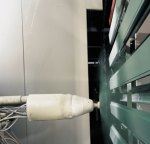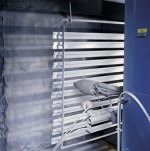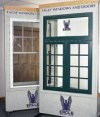Automated Paint Line Sends Productivity Soaring
An automated paint line has given Eagle® Window & Door the flexibility to finish more than 3, 000 aluminum parts in 10 to 20 colors during a single shift...
In the highly visible world of premium windows and doors, Eagle, Dubuque, IA, has become the supplier of choice among designers, architects, builders and property owners with special needs and high expectations. One reason for the high demand of Eagle's windows and doors is their resistance to a variety of environmental conditions. Once installed, the windows and doors are subjected to decades of extreme weathering, from direct sunlight to salty ocean air to cold mountain winds. Plus, the doors must withstand temperatures that range from –20-100F. "Through all of this, our finished product must continue to look great. After all," explained Brad Straka, facility engineer at Eagle, "an architect can build a $500,000 home and fill it with beautiful amenities, but most people will never see inside. However, the outside, including the windows and doors, can be seen by everyone who passes by. Naturally, expectations are very high."
However, this is not the only reason for the popularity of the company's windows and doors. "More and more, the marketplace wants special features that set their homes or buildings apart from the rest," said Mr. Straka. "They turn to us for customized shapes, sizes and colors that create a distinctive look. We have become the custom expert."
As market demand for special orders exploded during the last decade, Eagle was forced to keep up with the delivery schedules. Since Eagle's establishment in 1977, the company managed to meet delivery schedules by outsourcing the painting of its aluminum windows and doors to designated job shops. While the finish quality, consistency and durability from the paint shops were excellent, by 1997 outsourcing lead times became so extended that they were beginning to cost Eagle jobs.
In 1998, outsourcing lead times became too excessive, and Eagle eliminated outsourcing and established an inhouse paint operation. Eagle contacted Midway Industrial Supply, St. Paul, MN, to help it establish and meet its basic engineering specifications. Two goals were established: reduce lead time and decrease the cost of painting the windows and doors. To do this Eagle installed a fully automated, in-house paint line to finish all its aluminum parts, including cladding, screen channels and accessories.
The new paint operation was designed to be completely selfsufficient. Eagle wanted it to be treated like an independent supplier to the company. Since Eagle would be the paint shop's only customer, the 30,000sqft facility was equipped to meet very specific objectives.
Eagle manufactures more than 100 aluminum window and door profiles that range in size from 0.1875 inches wide to 14 ft long. Most orders involve relatively small custom jobs, 20 to 30 windows in specific shapes and designer colors, and are run on a "per order" basis. "We needed to finish between 3,000 to 4,000 parts per day with the flexibility to apply two to 20 colors during a single shift," stated Mr. Straka. "In short, we needed a paint system that could accommodate a multitude of part profiles, handle frequent color changes, match colors consistently and continuously, provide a quality finish and minimize paint waste and touchup." Therefore, batching and inven-torying solutions were out of the question.
The new paint facility is located less than a mile from Eagle's manufacturing operation. After the windows and doors are manufactured, they are "shipped" to the paint facility. At the paint shop, the windows and doors are presorted by individual orders, checked into a temporary holding area and manually loaded onto horizontal racks attached to an overhead conveyor moving at a constant speed of 8 fpm.
At the beginning of each day, Eagle knows that it will paint a certain number of orders this color and a certain number of orders that color, and it knows the order that the colors will be painted in. This information is then programmed into the paint line's control. Even though the control can be programmed to know that there are three white orders, two tan orders and five green orders, it cannot be programmed to know when one order ends and when the next one begins. So, to notify the control of an upcoming color change, Eagle places a color flag on the conveyor. Because the line moves at a constant speed, when the color flag breaks a line of light at a set distance from the booth, the control can calculate the exact time to make a color change.
Eagle also uses an automated triggering system from Nordson to automate its paint line. The triggering system includes an operator interface, PLC controller, photo cells and conveyor encoder. The paint line operator enters trigger points and delay on/delay off times into the operator interface. As parts pass through the photo cells, a signal is sent to the PLC. Again, because the line moves at a constant speed, the signal triggers the spray guns on as the leading edge of the part approaches the spray devices and triggers the spray guns off as the trailing edge of the part passes through the spray booth. "Control is a key feature," said Mr. Straka, "since every order requires a fairly unique racking pattern. For example, it's not unusual to see a single halfcircle window frame hung on a rack. The controls will minimize any waste." The precise control of the spray gun triggering not only minimizes paint waste, it also reduces cleanup costs and helps control VOC emissions.
Another important part of Eagle's automated system is the spray guns. Based on the finish quality achieved by the job shops that Eagle previously used, the company's engineers knew that they wanted to use rotary atomizers in the new paint system. "We investigated Nordson RA20 rotary atomizers and were immediately sold on the finish quality, minimal paint overspray and consistency from pieceto piece and rack to rack," stated Mr. Straka.
The rotary atomizers apply paint between 0.8 and 1.2 mil (dry) and are checked routinely to minimize the need for touchup. A manual spray booth is positioned immediately after the automated booths to reinforce coverage in unusual circumstances such as doublehung parts with extreme configurations and recesses. "Rejects are virtually nonexistent," proclaimed Mr. Straka.
Eagle currently uses an average of 110 gal of paint per day (shift) to coat 2,500 to 3,000 parts. "Rotary atomizer technology allows us to keep paint utilization very low," said Mr. Straka. "The ability to achieve closein painting gives us high transfer efficiency and good penetration. Likewise, spray pattern control of the rotary atomizers helps reduce overspray and paint waste." The rotary atomizers are positioned only 5 inches from the parts. This is possible because the spray guns do not have a minimum sparking distance.
"The automated paint line has given us tremendous flexibility," explained Mr. Straka. "We can now handle 10 to 12 different color changes and produce 3,000 finished parts every day. And, by eliminating the need to outsource, we've dramatically reduced our lead time on custom colors. Best of all, we've achieved all this and are only running at about a third of our capacity."
Looking into the future, sometime this year Eagle will make another big move to a new 400,000sqft building that will house offices, manufacturing and an allnew paint facility mirrored after the existing operation. "Based on the success and flexibility of our automated paint line, we will continue to expand our use of higher quality, higher durability paints, which means adding rotary atomizers into our primer coating booths," said Mr. Straka. "It's just another example of how we're 'Giving Vision to Great Ideas™'."
To learn more visit Nordson Corporation, Industrial Coating Systems.
Related Content
Conveyors and Paint Systems
Choosing the right conveyor system, coating technology, and ancillary equipment.
Read MoreCuring Oven Basics
Simply heating up the substrate does not cure the coating. There are many variables to consider when choosing the best cure oven for your application...
Read MoreZinc Phosphate: Questions and Answers
Our experts share specific questions about zinc phosphate and pretreatment
Read MoreCobot Enters Paint Industry With Safety at the Forefront
This collaborative robot is the first explosion-proof solution for the powder coating and paint arena that meets the U.S.’ stringent safety requirements. Its lead-through teach programming and tablet control are especially appealing to small shops with little proficiency in robotics.
Read MoreRead Next
A ‘Clean’ Agenda Offers Unique Presentations in Chicago
The 2024 Parts Cleaning Conference, co-located with the International Manufacturing Technology Show, includes presentations by several speakers who are new to the conference and topics that have not been covered in past editions of this event.
Read MoreEducation Bringing Cleaning to Machining
Debuting new speakers and cleaning technology content during this half-day workshop co-located with IMTS 2024.
Read MoreDelivering Increased Benefits to Greenhouse Films
Baystar's Borstar technology is helping customers deliver better, more reliable production methods to greenhouse agriculture.
Read More
.JPG;width=70;height=70;mode=crop)
















.jpg;maxWidth=300;quality=90)







